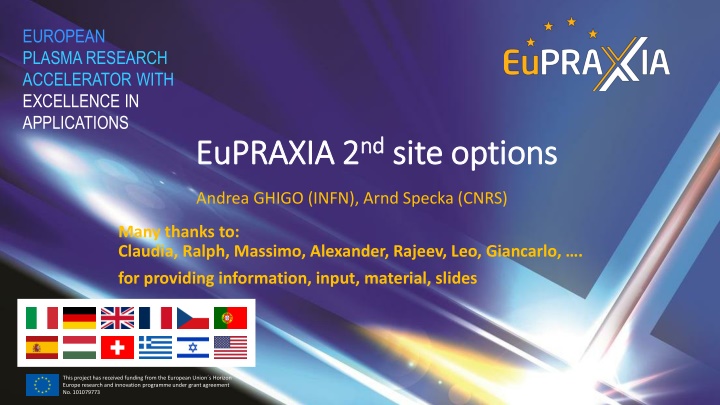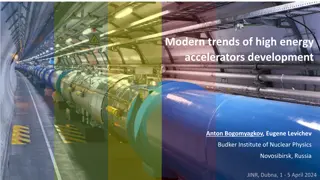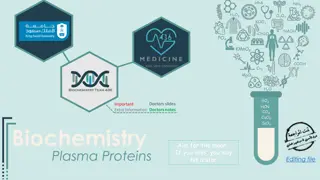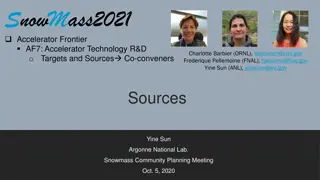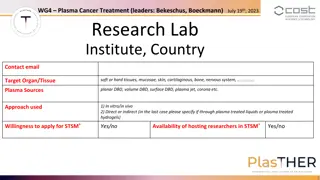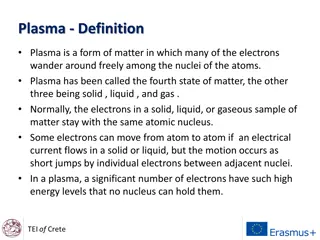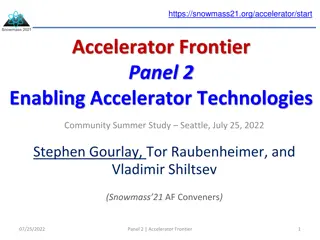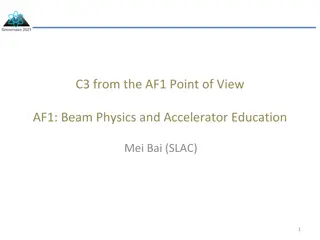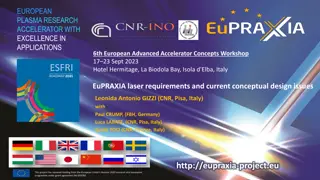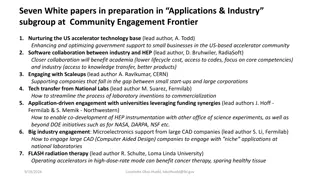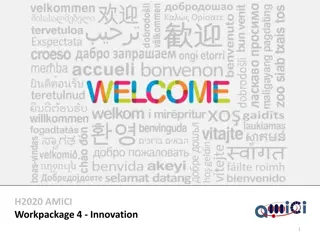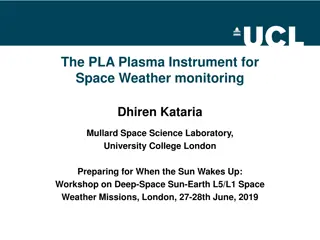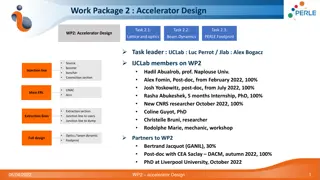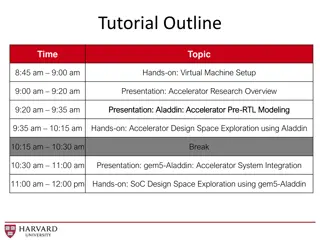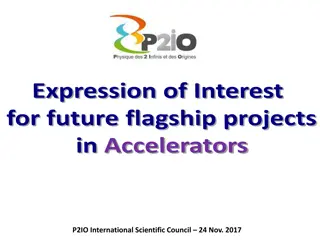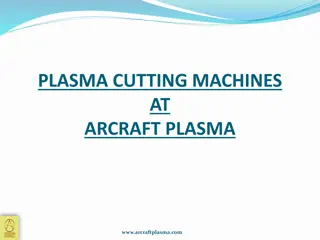European Plasma Research Accelerator with Excellence in Applications
The European Plasma Research Accelerator project, EuPRAXIA, funded by the European Union's Horizon Europe programme, aims to advance plasma accelerator technology for various applications. With phased construction sites and a focus on laser-driven and beam-driven plasma accelerators, the project envisions powering future advancements in fields like high-energy physics, medical imaging, and more. The project coordinators, Andrea Ghigo and Arnd Specka, lead the efforts towards innovation and excellence in accelerator research."
Download Presentation

Please find below an Image/Link to download the presentation.
The content on the website is provided AS IS for your information and personal use only. It may not be sold, licensed, or shared on other websites without obtaining consent from the author.If you encounter any issues during the download, it is possible that the publisher has removed the file from their server.
You are allowed to download the files provided on this website for personal or commercial use, subject to the condition that they are used lawfully. All files are the property of their respective owners.
The content on the website is provided AS IS for your information and personal use only. It may not be sold, licensed, or shared on other websites without obtaining consent from the author.
E N D
Presentation Transcript
EUROPEAN PLASMA RESEARCH ACCELERATOR WITH EXCELLENCE IN APPLICATIONS EuPRAXIA 2 EuPRAXIA 2nd ndsite options site options Andrea GHIGO (INFN), Arnd Specka (CNRS) Many thanks to: Claudia, Ralph, Massimo, Alexander, Rajeev, Leo, Giancarlo, . for providing information, input, material, slides This project has received funding from the European Union s Horizon Europe research and innovation programme under grant agreement No. 101079773
Why us? Funded by the European Union WP3 : Organization and Rules coordinators: Andrea GHIGO (INFN) Arnd SPECKA (CNRS) 2nd site
Phased Implementation of Construction Sites Funded by the European Union Beamline BB-A: Radiation sources INFN (Italy): Facility for beam-driven plasma accelerators Laser-driven Beam-driven FEL user area 1 Undulator Undulator Phase 1 FEL beamline to 1 GeV + user area 1 Ultracompact positron source beamline + positron user area FEL beamline to 1 GeV + user area 1 GeV-class positrons beamline + positron user area Plasma Accelerator FEL user area 2 ICS X-ray source user area (BU3) RF RF Accelerator Injector HEP detector test user area X-ray imaging beamline + user area Table-top test beams user area FEL user area 2 FEL to 5 GeV ICS source beamline + user area HEP detector tests user area FEL user area 2 FEL to 5 GeV Phase 2 Plasma Accelerator Conversion & conditioning laser GeV-class positron user area electrons positrons Beamline BB-B: GeV-class positrons & HEP detector test stand Beamline LB-C: X-ray imaging life sciences & materials Facility for laser-driven plasma accelerators Life-science & materials X- ray imaging user area Plasma Injector High-field physics beamline / user area Other future developments Medical imaging beamline / user area Other future developments Phase 3 Beamline LB-B: Positron beam source & table-top test beam Table-top test beam user area Plasma Accelerator Conversion & conditioning Plasma Injector Ultracompact positron source user area Laser FEL user area 1 Plasma Accelerator Undulator Undulator RF Injector FEL user area 2 Beamline LB-A: FEL R. Assmann, M. Ferrario - 4 July 2023 3
Baseline Scenario for 2nd Site Assessment Baseline Scenario for 2nd Site Assessment ( (proposal proposal R.A.) R.A.) Funded by the European Union EuPRAXIA CDR contains various options and scenarios, also for second site. Baseline scenario to be defined. Here (my) first thoughts on possible approach: Assessment on operational laser-driven 1 GeV plasma FEL (20 Hz, 30 pC) as requirement for initial operation: space, investment cost, person-power, brilliance, space & time for users, Choose your favorite scheme (1 or 2 stage, all optical or plasma plus RF, injection scheme, ). Beneficial in review: Additional applications & user beamlines (time plan & resource needs), test plan for 2 stage plasma acceleration Outlook: Upgrade plan to 100 Hz, to 5 GeV FEL, including eventually required R&D, personnel cost, invest budget for implementation Laser-driven FEL beamline to 1 GeV + user area 1 Ultracompact positron source beamline + positron user area X-ray imaging beamline + user area Table-top test beams user area FEL user area 2 FEL to 5 GeV High-field physics beamline / user area Other future developments Phase 1 Phase 2 Phase 3 R. Assmann, M. Ferrario - 4 July 2023 4
Selection Criteria 2 Selection Criteria 2nd (from CDR, fulfilled by 1st Site LNF/INFN) nd EuPRAXIA Site EuPRAXIA Site Funded by the European Union Legal/Political Technical Financial Commitment to sustainability of EuPRAXIA (host lab covers site operation costs) Compliance of host institution with EuPRAXIA Access Policy Site provides sufficient space (about 175 m x 35 m) Compliance of host institution with EuPRAXIA Open Innovation and Open Science Policy Laboratory has infrastructures in one or several of RF accelerators, laser installations, user access. Previous investments into local infrastructures of relevance for EuPRAXIA (leverage effect) Agreement of host institution with the long-term scientific agenda of EuPRAXIA Site provides required services and facilities for support of external users, including E infrastructure Existence of one or a mix of funding sources able to finance implementation of the site Laboratory has existing groups in place to guarantee safety requirements (laser, radio-protection, access control) and rules Note: approach reduces cost (pre-invest) and risks of cost-overun. R. Assmann, M. Ferrario - 7 June 2023 5
Assessment criteria: Infrastructure Assessment criteria: Infrastructure Funded by the European Union o Infrastructure and Facilities: power supply, cooling systems, access to water, and available land area. o Geographic Location: accessibility for researchers, collaborators, and users. proximity to transportation hubs, on site or close accommodation o Local Support and Expertise: local expertise in accelerator science, engineering. Presence of universities, research institutions, and industry. o Environmental Considerations: environmental impact, potential risks to the local ecosystem or population. o Collaborative Opportunities: synergy with existing scientific communities, research projects, and facilities in the vicinity. o Funding and Cost Considerations: availability of funding sources, potential construction costs, and the overall cost of operations and maintenance o Legal and Regulatory Factors: legal and regulatory framework of the host country or region. factors such as Licensing requirements, permitting processes, and any potential restrictions o Defense/National Security connection (if any) : How well is the separation drawn out? Are there access restrictions? o Political Stability: long-term commitment to scientific infrastructure development o Safety and Security: including emergency response capabilities, physical security systems o Future Expansion Potential: potential for future expansion and upgrade of the accelerator facility at the selected site. Insert author and occasion 6
Assessment criteria: LPA specific Assessment criteria: LPA specific Funded by the European Union o Laser Infrastructure: existing laser infrastructure capable of driving the LPA: energy, repetition rate, pulse duration, and beam quality o Beam Quality and Stability: pointing stability, beam profile, energy stability, temporal characteristics o Laser Synchronization: with the electron beam generation and acceleration processes. o Beam Diagnostics and Control: of the accelerated electron beams, including parameters such as energy, emittance, charge, and divergence. o Experimental Infrastructure: readiness of beamlines, vacuum systems, target systems, and radiation shielding o Radiation Safety: shielding measures, personnel protection protocols, and monitoring systems o Data Acquisition and Analysis: data acquisition, storage, and analysis, high-speed, computational and network resources, data volume o Collaboration Potential: opportunities to leverage complementary expertise and resources o Future Upgrade and Scalability: potential for future upgrades and scalability. Flexibility of the existing infrastructure, accommodate technological advancements o Technical Support: availability of skilled technical staff and support services at the site. Experienced engineers, physicists, and technicians. Insert author and occasion 7
2 2nd nd site candidates site candidates Funded by the European Union ELI-Beamlines, Prague, CZc EPAC,Didcot, GB CLPU,Salamanca, ES CNR,Pisa, IT Insert author and occasion 8
Ground area for extensions identified Ground area for extensions identified Funded by the European Union ELI-Beamlines, Prague, CZc EPAC,Didcot, GB CLPU,Salamanca, ES CNR,Pisa, IT Insert author and occasion 9
from 2nd nd site proponents site proponents Wishlists Wishlists from 2 Funded by the European Union ELI-Beamlines, Prague, CZc EPAC,Didcot, GB Wish list for 2nd Site PISA The construction of the 2nd site in Pisa would be based on the experience gained by the CNR group over more than 20 years of operation of the Intense Laser Irradiation Laboratory (ILIL) and including the commissioning of the FLAME laser facility at LNF-INFN. The Site 2 of the EuPRAXIA infrastructure, namely the LASER-driven site, is unique in its kind for the scientific mission, for the scale and for the advanced science and technology of the proposed laser and plasma components. Building design and construction: the construction or the Pisa 2nd site is foreseen to be designed as a new building, starting from the green field, to ensure proper construction and full architectural compliance with sustainability and environmental guidelines. Such conditions would be difficult to attain with adaptation ad extension of existing lab space and would require stop of operations of the existing facility. Collaboration with experts of infrastructures and facility design (e.g. INFN, STFC, ELI, ESS etc.) is expected to deliver the first concept of 2nd Site. Laser driver: based on the existing conceptual design, a path for construction and commissioning is being identified. A first step is already being taken with the definition of the laser front-end specifications of a 100 Hz repetition rate system that is currently being procured (EUAPS). The following steps include technical design of the amplification chain, compression, transport and focusing to target and will require strong contribution from many EuPRAXIA partners. A list of R&D items (and possible EUPRAXIA partners/contributors) include 100 J amplifier design (STFC), kW average power beam transport (ELI-BL) and compressor gratings (DESY), passive and active mechanical stabilization (CNRS), pump laser design (AMPLITUDE, THALES, STFC), high efficient laser diodes (FBH), components lifetime test bed ELI-BL), cryo lab development (AMPLITUDE) etc. Specifically for the Multi pulse driver concept (REMPI), main contribution is expected from ELI-NP and from OXFORD, possibili with in-kind contributions. Plasma components: The required plasma components will be defined according to the selected acceleration scheme (jet, cell, capillary etc ..). Here delivery is expected from leading partners in this areas, including industrial partners (e.g. SOURCELAB) that have developed engineered components for user operation. Plasma diagnostics: The Pisa group has an extensive experience in the development and fielding of plasma diagnostics, including data acquisition and analysis. On line plasma diagnostics for the 2nd site will be designed and developed based on this this expertise and taking advantage of unique capabilities of selected partners (CNRS, STFC etc ). Electron beam diagnostics: Main contribution to beam diagnostics is expected from INFN and DESY. Undulators: Main contribution to beam diagnostics is expected from INFN and DESY. CLPU,Salamanca, ES CNR,Pisa, IT Insert author and occasion 10
from 2nd first impressions first impressions nd site candidates: site candidates: Wishlists Wishlists from 2 Funded by the European Union Thanks to impressive pre-investment (existing infrastructures, human resources, and technological expertise) all candidates appear to have in hand many (if not all) key components for achieving phase 1! Desired contributions from CoE are not identical for each candidate. (e.g. betatron, positrons for ELI-BL) -> complementarity Potential synergies between 1st site (LNF) and 2nd site should be explored more deeply. (e.g. Control systems, design of user areas, photon line, ML beam optimization, plasma lenses) Strong transverse needs identified, e.g. start-to-end simulations Insert author and occasion 11
Towards an unified qualitative assessment criteria Towards an unified qualitative assessment criteria 0 0- -order draft order draft Funded by the European Union How long-standing/strong is the lab s expertise in: High power laser, Electron beam , X-ray optics, FEL operation , synchrotron radiation users, user management Does the lab have equipment that can be partly or fully dedicated to EuPRAXIA? High power (PW) laser, Interaction plasma chamber, Electron /photon transfer lines, undulator, X-ray transfer line, User end station What is the available space, as building or as construction grounds, for laser, undulator, transport line, user areas Are there conflicts with the operation of the existing facility (space, HR,..) and how can they be circumvented? Insert author and occasion 12
Towards an unified qualitative assessment criteria Towards an unified qualitative assessment criteria 0 0- -order draft order draft Funded by the European Union What is the labs evaluation of pre-investment and require extra- investment for : infrastructure construction (building, shielded area .) equipment (laser, electron and photon beam lines, undulators) operational cost (HR, spares, consumables Operation number of hours dedicated to users per year number of hours dedicated to machine development per year operation scheme (beam hours/day, development or maintenance days/month) Human ressources Number of people dedicated to Laser maintenance Number of people dedicated to equipment user operation Number of people dedicated to Beam lines Insert author and occasion 13
Managerial concept Funded by the European Union quoted from the ESFRI proposal The overall managerial concept of EuPRAXIA therefore implements the scenario where the European field comes together for common design and construction of a European plasma accelerator facility, which shall be installed in two central locations for two complementary driver technologies (one for beam and one for laser drivers). Both sites share common technical designs, prototyping and production for many components. The model applied here takes the example of a large High Energy Physics detector, that is designed and constructed by a wide collaboration A.Ghigo, A.Specka- EuPRAXIA-PP Kick-off meeting 24-25 Nov 2022
User User Categories Categories Funded by the European Union WP5 "User Strategy & Services" (D. Bleiner ,E. Principi , G. Sarri, F. Stellato) Please fill out Users requirements survey https://surveys.infn.it/index.php/718177 R. Assmann, M. Ferrario - 4 July 2023 15
Collaboration models: HEP detector Collaboration models: HEP detector Funded by the European Union Many other models exist: observatories (ELT, CTA, KM3NET) , supercomputers (PRACE), radiation facilities (XFEL,ESS, ESRF), accelerators (HL-LHC, FAIR, SPIRAL2) Collaboration agreement, bodies, in/out criteria Contributed parts: subdetectors + Trigger + DAq/Control + Computing + Spares Construction funding: institute salaries, national funding (e.g. France: TGIR) Integration closely supervised and coordinated by host lab Members: builders and users (the builders are the users) Competing detector technologies: arbitration by collaboration (not painless ) Reward: perennial (and - so far - exclusive) access to the data Physics publication signed by all (active) members (shifts, M&O cost paid) Technical publications signed by the actual development teams No country-wise attribution of competences/purview Insert author and occasion 16
What is needed now? (personal view) What is needed now? (personal view) Funded by the European Union Set up working working group for defining 2nd site candidate assessment criteria. Should contain: WP1Project leaders (MF, RA->NN), financial and legal expert (AF), WP3 coordinators, 1 representative of candidate site. Refine uniform assessment criteria list (comparability) -> WP1,3,4 Each candidate site should identify one (or two) preferred international/european collaboration models (ideally distributed ESFRI project or landmark). Identify a very restricted number of phase 1 scenarios for start-to-end simulations -> WP Theory and simulation Reinforce the appearance as a single RI (with two sites): identify concrete common developments for (but not necessarily done by) Site 1 and Site 2. Implementation engineering team in each site Insert author and occasion 17
Summary Summary Funded by the European Union We are lucky! There are 4 good and motivated candidates for the 2nd site. Visits to candidate sites and (possibly meeting with officials) are scheduled. Original 2nd site decision time was unfeasible -> amendment of deliverable dates must happen now! Choice of an appropriate*) collaboration model is crucial. *) familiar and appreciated by the funding agencies of all partners. EuPRAXIA will have the organizational model that YOU will shape, and follow rules that YOU will have set. YOUR input is required and will be requested. A.Ghigo, A.Specka- EuPRAXIA-PP Kick-off meeting 24-25 Nov 2022
